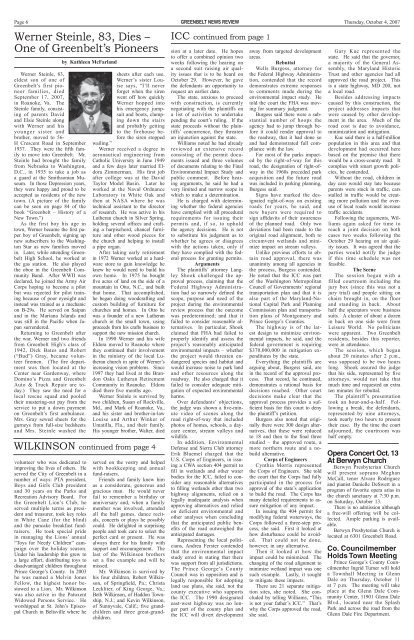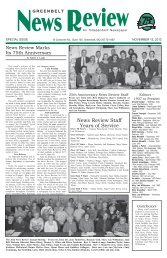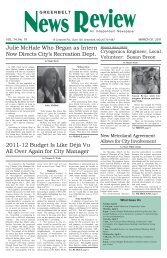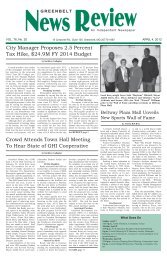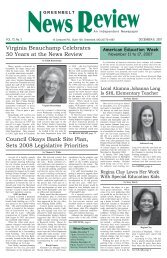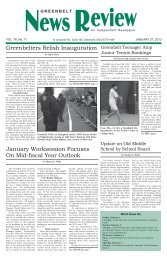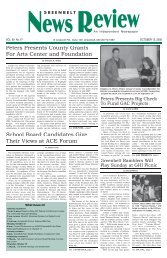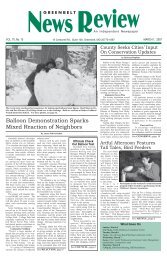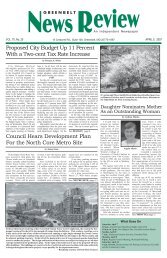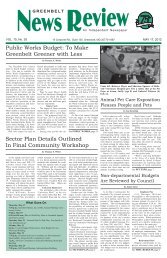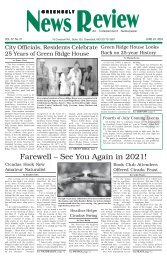October 4 - Greenbelt News Review
October 4 - Greenbelt News Review
October 4 - Greenbelt News Review
You also want an ePaper? Increase the reach of your titles
YUMPU automatically turns print PDFs into web optimized ePapers that Google loves.
Page 6 GREENBELT NEWS REVIEW Thursday, <strong>October</strong> 4, 2007<br />
Werner Steinle, 83, Dies –<br />
One of <strong>Greenbelt</strong>’s Pioneers<br />
Werner Steinle, 83,<br />
eldest son of one of<br />
<strong>Greenbelt</strong>’s first pioneer<br />
families, died<br />
September 17, 2007,<br />
in Roanoke, Va. The<br />
Steinle family, consisting<br />
of parents David<br />
and Elsie Steinle along<br />
with Werner and his<br />
younger sister and<br />
brother, moved to 56-<br />
H Crescent Road in September<br />
1937. They were the fifth family<br />
to move into <strong>Greenbelt</strong>. Mr.<br />
Steinle had brought the family<br />
from Nebraska to Washington,<br />
D.C., in 1935 to take a job as<br />
a guard at the Smithsonian Museum.<br />
In those Depression years,<br />
they were happy and proud to be<br />
accepted as residents of the new<br />
town. (A picture of the family<br />
can be seen on page 84 of the<br />
book “<strong>Greenbelt</strong> – History of a<br />
New Town.”)<br />
As the first boy his age in<br />
town, Werner became the first paper<br />
boy of <strong>Greenbelt</strong>, signing up<br />
new subscribers to the Washington<br />
Star as new families moved<br />
in. Later, while attending <strong>Greenbelt</strong><br />
High School, he worked at<br />
the gas station. He also played<br />
the oboe in the <strong>Greenbelt</strong> Community<br />
Band. After WWII was<br />
declared, he joined the Army Air<br />
Corps hoping to become a pilot<br />
but was rejected for pilot training<br />
because of poor eyesight and<br />
instead was trained as a mechanic<br />
on B-29s. He served on Saipan<br />
and in the Mariana Islands and<br />
was still in the Pacific when Japan<br />
surrendered.<br />
Returning to <strong>Greenbelt</strong> after<br />
the war, Werner and two friends<br />
from <strong>Greenbelt</strong> High’s class of<br />
1942, Dick Bates and Robert<br />
(“Bud”) Gray, became volunteer<br />
firemen. (The fire department<br />
was then located at the<br />
Center near Gardenway, where<br />
Domino’s Pizza and <strong>Greenbelt</strong><br />
Auto & Truck Repair are today.)<br />
They saw the need for a<br />
local rescue squad and pooled<br />
their mustering-out pay from the<br />
service to put a down payment<br />
on <strong>Greenbelt</strong>’s first ambulance.<br />
Mrs. Gray sewed sheets for the<br />
gurneys from full-size bedsheets<br />
and Mrs. Steinle washed the<br />
by Kathleen McFarland<br />
WILKINSON continued from page 4<br />
volunteer who was dedicated to<br />
improving the lives of others. He<br />
served the City of <strong>Greenbelt</strong> in a<br />
number of ways: PTA president,<br />
Boys and Girls Club president<br />
and 30 years on the Parks and<br />
Recreation Advisory Board. For<br />
the <strong>Greenbelt</strong> Lion’s Club, he<br />
served multiple terms as president<br />
and treasurer, took key roles<br />
in White Cane (for the blind)<br />
and the pancake breakfast fundraisers.<br />
He took special pride<br />
in managing the Lions’ annual<br />
“Toys for Needy Children” campaign<br />
over the holiday season.<br />
Under his leadership this grew to<br />
a large effort, distributing toys to<br />
disadvantaged children throughout<br />
Prince George’s County. In 2003<br />
he was named a Melvin Jones<br />
Fellow, the highest honor bestowed<br />
to a Lion. Mr. Wilkinson<br />
was also active in the Patuxent<br />
Widowed Persons Service. He<br />
worshipped at St. John’s Episcopal<br />
Church in Beltsville where he<br />
sheets after each use.<br />
Werner’s sister Louise<br />
says, “I’ll never<br />
forget when the siren<br />
went off how quickly<br />
Werner hopped into<br />
his emergency jumpsuit<br />
and boots, clumping<br />
down the stairs<br />
and probably getting<br />
to the firehouse before<br />
the siren stopped<br />
wailing.”<br />
Werner received a degree in<br />
aeronautical engineering from<br />
Catholic University in June 1949<br />
and a few days later married Eldora<br />
Zimmerman. His first job<br />
after college was at the David<br />
Taylor Model Basin. Later he<br />
worked at the Naval Ordnance<br />
Laboratory in White Oak and<br />
then at NASA where he was<br />
technical assistant to the director<br />
of research. He was active in his<br />
Lutheran church in Silver Spring,<br />
holding several offices and crafting<br />
a harpischord, chancel furniture<br />
and other wood pieces for<br />
the church and helping to install<br />
a pipe organ.<br />
After taking early retirement<br />
in 1972 Werner worked at a hardware<br />
store to gain knowledge he<br />
knew he would need to build his<br />
own home. In 1975 he bought<br />
five acres of land on the side of a<br />
mountain in Otto, N.C., and built<br />
that home. That accomplished,<br />
he began doing woodcrafting and<br />
custom building of furniture for<br />
churches and homes. In Otto he<br />
was a founder of a new Lutheran<br />
church in the small town, using<br />
proceeds from his crafts business to<br />
support the new mission church.<br />
In 1990 Werner and his wife<br />
Eldora moved to Roanoke where<br />
they continued their involvement<br />
in the ministry of the local Lutheran<br />
church in spite of Werner’s<br />
increasing vision problems. Since<br />
1997 they had lived at the Brandon<br />
Oaks Lutheran Retirement<br />
Community in Roanoke. Eldora<br />
died there five months ago.<br />
Werner Steinle is survived by<br />
two children, Susan of Rockville,<br />
Md., and Mark of Roanoke, Va.,<br />
and his sister and brother-in-law<br />
Louise and Arthur Winker of<br />
Umatilla, Fla., and their family.<br />
His younger brother, Walter, died<br />
served on the vestry and helped<br />
with bookkeeping and annual<br />
fund-raisers.<br />
Friends and family knew him<br />
as a considerate, generous and<br />
gracious man. He would never<br />
fail to remember a birthday or<br />
anniversary and, when a family<br />
member was involved, attended<br />
all the ball games, dance recitals,<br />
concerts or plays he possibly<br />
could. He delighted in surprising<br />
people and took care to select the<br />
perfect card or present. He was<br />
always there for his family with<br />
support and encouragement. The<br />
last of the Wilkinson brothers<br />
set a fine example and will be<br />
missed.<br />
Mr. Wilkinson is survived by<br />
his four children, Robert Wilkinson,<br />
of Springfield, Pa.; Christa<br />
Leckliter, of King George, Va.;<br />
Beth Wilkinson, of Haddon Township,<br />
N.J.; and Kevin Wilkinson,<br />
of Sunnyvale, Calif.; five grandchildren<br />
and three great-grandchildren.<br />
ICC continued from page 1<br />
sion at a later date. He hopes<br />
to offer a combined opinion two<br />
weeks following the hearing on<br />
a second suit raising air quality<br />
issues that is to be heard on<br />
<strong>October</strong> 29. However, he gave<br />
the defendants an opportunity to<br />
request an earlier date.<br />
The state, anxious to proceed<br />
with construction, is currently<br />
negotiating with the plaintiffs on<br />
a list of activities to undertake<br />
pending the court’s ruling. If the<br />
state proceeds without the plaintiffs’<br />
concurrence, they threaten<br />
an injunction against the state.<br />
Williams noted he had already<br />
reviewed an extensive record<br />
consisting of the permit documents<br />
issued and three volumes<br />
of documents relating to the Final<br />
Environmental Impact Study and<br />
public comment. Before hearing<br />
arguments, he said he had a<br />
very limited and narrow scope in<br />
which to make a determination.<br />
He is charged with determining<br />
whether the federal agencies<br />
have complied with all procedural<br />
requirements for issuing their<br />
permits and, if so, to uphold<br />
the agency decisions. He is not<br />
to substitute his judgment as to<br />
whether he agrees or disagrees<br />
with the actions taken, only if<br />
they have complied with the federal<br />
process for granting permits.<br />
Arguments<br />
The plaintiffs’ attorney Langley<br />
Shook challenged the approval<br />
process, claiming that the<br />
Federal Highway Administration<br />
had so narrowly defined the<br />
scope, purpose and need of the<br />
project during the environmental<br />
review process that the outcome<br />
was predetermined; and that it<br />
failed to consider reasonable alternatives.<br />
In particular, Shook<br />
claimed that FHA had failed to<br />
properly identify and assess the<br />
project’s reasonably anticipated<br />
environmental impacts – whether<br />
the project would threaten endangered<br />
species and habitat and<br />
would increase noise to park land<br />
and other resources along the<br />
roadway. He also charged that it<br />
failed to consider adequate mitigation<br />
of expected environmental<br />
harms.<br />
Over defendants’ objections,<br />
the judge was shown a five-minute<br />
video of scenes along the<br />
road right-of-way that included<br />
photos of homes, schools, a daycare<br />
center, stream valleys and<br />
wildlife.<br />
In addition, Environmental<br />
Defense and Sierra Club attorney<br />
Erik Bluemel charged that the<br />
U.S. Corps of Engineers, in issuing<br />
a CWA section 404 permit to<br />
fill in wetlands and other water<br />
bodies for the ICC, failed to consider<br />
any reasonable alternatives<br />
to filling wetlands other than two<br />
highway alignments, relied on a<br />
legally inadequate analysis when<br />
approving alternatives and relied<br />
on deficient environmental and<br />
other analyses when concluding<br />
that the anticipated public benefits<br />
of the road outweighed the<br />
anticipated damages.<br />
Representing the local politicians,<br />
Andrea Ferster contended<br />
that the environmental impact<br />
study erred in stating that there<br />
was support from all jurisdictions.<br />
The Prince George’s County<br />
Council was in opposition and is<br />
legally responsible for adopting<br />
land use plans, she said, not the<br />
county executive who supports<br />
the ICC. The 1990 designated<br />
east-west highway was no longer<br />
part of the county plan and<br />
the ICC will divert development<br />
away from targeted development<br />
areas.<br />
Rebuttal<br />
Wells Burgess, attorney for<br />
the Federal Highway Administration,<br />
contended that the record<br />
demonstrates extreme responses<br />
to comments made during the<br />
environmental impact study. He<br />
told the court the FHA was moving<br />
for summary judgment.<br />
Burgess said there were a substantial<br />
number of hoops the<br />
agency had to jump through before<br />
it could render approval to<br />
the roadway, that it had done so<br />
and had demonstrated full compliance<br />
with the law.<br />
For most of the parks impacted<br />
by the right-of-way for this<br />
road, the designation of right-ofway<br />
in the 1960s preceded park<br />
acquisition and the future road<br />
was included in parking planning,<br />
Burgess said.<br />
Signs have marked the designated<br />
right-of-way on existing<br />
roads for years, he said, and<br />
new buyers were required to<br />
sign affidavits of their awareness<br />
of the planned road. Only two<br />
deviations had been made to the<br />
original road alignment, both to<br />
circumvent wetlands and minimize<br />
impact on stream valleys.<br />
Unlike previous efforts to obtain<br />
road approval, there was<br />
unanimity among all agencies in<br />
the process, Burgess contended.<br />
He noted that the ICC was part<br />
of the Washington Metropolitan<br />
Council of Governments’ regional<br />
transportation plan and that it is<br />
also part of the Maryland-National<br />
Capital Park and Planning<br />
Commission plan and transportation<br />
plans of Montgomery and<br />
Prince George’s Counties.<br />
The highway is of the latest<br />
design to minimize environmental<br />
impacts, he said, and the<br />
federal government is requiring<br />
$370,000,000 in mitigation expenditures<br />
by the state.<br />
Everything the plaintiffs are<br />
arguing about, Burgess said, are<br />
in the record of the approval process.<br />
That record, he continued,<br />
demonstrates a rational basis for<br />
decisions reached. Other court<br />
decisions make clear that the<br />
approval process provides a sufficient<br />
basis for this court to deny<br />
the plaintiff’s petition.<br />
Burgess also noted that originally<br />
there were 300 design alternatives,<br />
that these were reduced<br />
to 18 and then to the final three<br />
studied – the approved route, a<br />
more northern route and a nobuild<br />
alternative.<br />
Corps of Engineers<br />
Cynthia Morris represented<br />
the Corps of Engineers. She told<br />
the court that the Corps had fully<br />
participated in the process for<br />
approval of the state’s application<br />
to build the road. The Corps has<br />
many detailed requirements to assure<br />
mitigation of any impact.<br />
In issuing the 404 permit for<br />
modifying federal waterways, the<br />
Corps followed a three-step process,<br />
she said. First it looked at<br />
how disturbance could be avoided.<br />
That could not be done,<br />
however, in any alternative.<br />
Then it looked at how the<br />
impact could be minimized. The<br />
changing of the road alignment to<br />
minimize wetland impact was one<br />
such example. Lastly, it sought<br />
to mitigate these impacts.<br />
There are 21 separate mitigation<br />
sites, she noted. She concluded<br />
by telling Williams, “This<br />
is not your father’s ICC.” That’s<br />
why the Corps approved the road,<br />
she said.<br />
Gary Kuc represented the<br />
state. He said that the governor,<br />
a majority of the General Assembly,<br />
the Maryland Historic<br />
Trust and other agencies had all<br />
approved the road project. This<br />
is a state highway, MD 200, not<br />
a local road.<br />
Besides addressing impacts<br />
caused by this construction, the<br />
project addresses impacts that<br />
were caused by other development<br />
in the area. Much of the<br />
road cost is due to avoidance,<br />
minimization and mitigation.<br />
Kuc said there is a half-million<br />
population in this area and that<br />
development had occurred here<br />
based on the premise that there<br />
would be a cross-county road. It<br />
complies with smart growth policies,<br />
he contended.<br />
Without the road, children in<br />
day care would stay late because<br />
parents were stuck in traffic, cars<br />
stalled in traffic would be creating<br />
more pollution and the overuse<br />
of local roads would increase<br />
traffic accidents.<br />
Following the arguments, Williams<br />
again asked for time to<br />
reach a joint decision on both<br />
cases two weeks following the<br />
<strong>October</strong> 29 hearing on air quality<br />
issues. It was agreed that the<br />
parties would notify the judge<br />
if this time schedule was not<br />
feasible.<br />
The Scene<br />
The session began with a<br />
filled courtroom including the<br />
jury box (since this was not a<br />
jury trial) and people sitting on<br />
chairs brought in, on the floor<br />
and standing in back. About<br />
half the spectators wore business<br />
suits. A cluster of about a dozen<br />
in back on one side were from<br />
Leisure World. No politicians<br />
were apparent. Two <strong>Greenbelt</strong><br />
residents, besides this reporter,<br />
were in attendance.<br />
The session, which began<br />
about 20 minutes after 2 p.m.,<br />
was supposed to be two hours<br />
long. Shook assured the judge<br />
that his side, represented by five<br />
attorneys, would not take that<br />
much time and requested an extra<br />
ten minutes for rebuttal.<br />
The plaintiff’s presentation<br />
took an hour-and-a-half. Following<br />
a break, the defendants,<br />
represented by nine attorneys,<br />
took nearly two hours to present<br />
their case. By the time the court<br />
adjourned, the courtroom was<br />
half empty.<br />
Opera Concert Oct. 13<br />
At Berwyn Church<br />
Berwyn Presbyterian Church<br />
will present soprano Meghan<br />
McCall, tenor Alvaro Rodríguez<br />
and pianist Danielle DeSwert in a<br />
program of favorite opera arias in<br />
the church sanctuary at 7:30 p.m.<br />
on Saturday, <strong>October</strong> 13.<br />
There is no admission although<br />
a free-will offering will be collected.<br />
Ample parking is available.<br />
Berwyn Presbyterian Church is<br />
located at 6301 <strong>Greenbelt</strong> Road.<br />
Co. Councilmember<br />
Holds Town Meeting<br />
Prince George’s County Councilmember<br />
Ingrid Turner will hold<br />
a Townhall Meeting in Glenn<br />
Dale on Thursday, <strong>October</strong> 11<br />
at 7 p.m. The meeting will take<br />
place at the Glenn Dale Community<br />
Center, 11901 Glenn Dale<br />
Blvd., located near the Splash<br />
Park and across the road from the<br />
Glenn Dale Fire Department.


